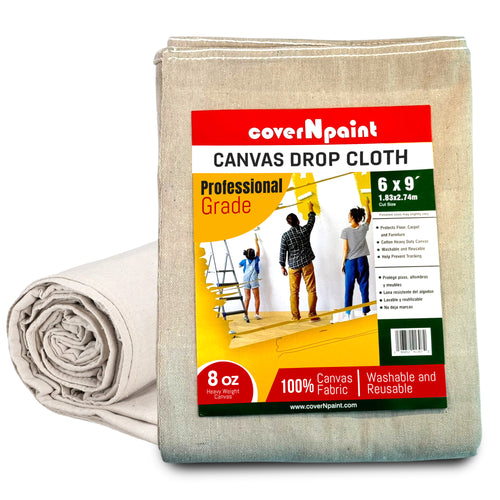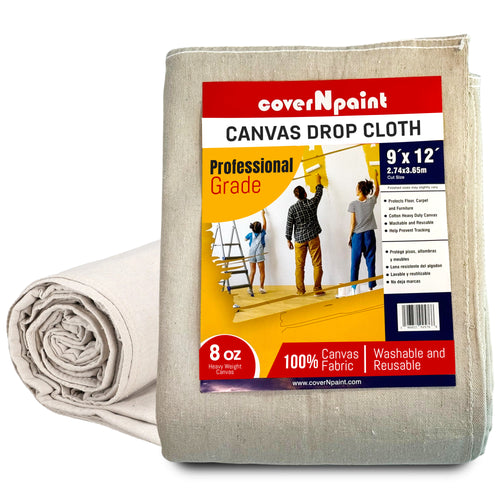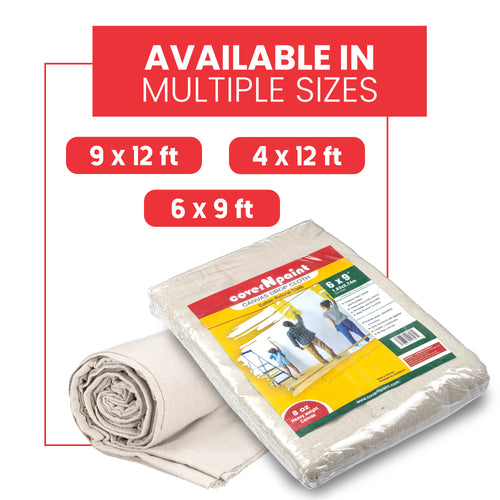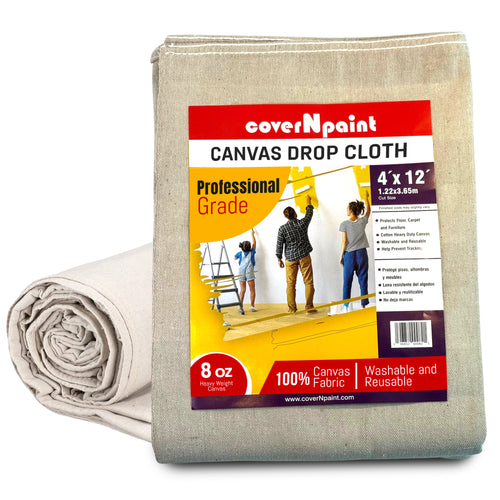Choosing the right painters drop cloth is critical for protecting your floors, furniture, and workspaces during painting projects. Both canvas drop cloths and synthetic drop cloths are popular options, but each has unique features that make it suitable for specific applications. Understanding the differences between them will help you make an informed choice and ensure that your surfaces stay safe from spills, drips, and stains.
Why The Right Drop Cloth Matters
DIY enthusiasts and professional painters often face issues like paint seepage, slips, or staining of surfaces. Selecting the wrong paint drop cloth can lead to damage, extra cleanup, and wasted money. High-quality drop cloths are designed to absorb paint, stay in place, and endure repeated use, providing both efficiency and peace of mind.
What Are Canvas Painters Drop Clothes?
Canvas drop cloths are made from tightly woven natural cotton fibers, offering superior absorbency and durability. They are reusable, environmentally friendly, and suitable for most indoor painting tasks.
Key Advantages of Canvas Drop Cloths:
-
Absorbency: Absorbs paint spills, preventing seepage to floors.
-
Durability: Resistant to tearing even under ladders and heavy equipment.
-
Reusable: Can be washed and reused multiple times, reducing waste.
-
Eco-Friendly: Made from natural fibers and biodegradable materials.
Best Use Cases:
-
Hardwood floors, tile surfaces, and carpet protection
-
Professional projects requiring repeated use
-
Large projects where stability and weight are important
For more insights on eco-friendly canvas options, check out our detailed blog: Eco-Friendly Advantages of Using a Canvas Painters Drop Cloth in 2025.
What Are Synthetic Painters Drop Cloths?
Synthetic drop cloths are made from materials like polypropylene, polyester, or plastic blends. They are typically lighter and cheaper than canvas options but vary in performance.
Key Advantages of Synthetic Drop Cloths:
-
Lightweight: Easy to carry and position during painting tasks.
-
Waterproof: Protects against spills, especially for small touch-ups.
-
Low Cost: Affordable for one-time projects or short-term use.
Drawbacks:
-
Slippage: Lighter synthetic materials may move, requiring tape or weights.
-
Limited Absorbency: Paint may pool or run if not cleaned immediately.
-
Durability Issues: Susceptible to tearing under heavy equipment or repeated use.
Best Use Cases:
-
Small DIY projects
-
Outdoor painting where temporary coverage is needed
-
Situations requiring waterproof protection over absorbency
Comparing Canvas vs Synthetic Painters Drop Cloths
|
Feature |
Canvas Drop Cloth |
Synthetic Drop Cloth |
|
Material |
Natural cotton fibers |
Plastic, polypropylene, or polyester |
|
Absorbency |
High – absorbs paint and spills |
Low – primarily acts as a barrier |
|
Durability |
High – reusable and tear-resistant |
Moderate – prone to tearing |
|
Environmental Impact |
Eco-friendly and biodegradable |
Non-biodegradable, creates waste |
|
Stability |
Heavy, stays in place |
Light, may require anchoring |
|
Ideal Projects |
Large indoor projects, repeat use |
Small, short-term, outdoor projects |
From the table, it’s clear that canvas drop cloths are best for long-term protection and repeated use, while synthetic drop cloths are suitable for short-term, small-scale projects.
People’s Pain Points & Practical Solutions
Pain Point 1: Slipping Drop Cloths
Solution: Choose heavier canvas drop cloths or use painter’s tape to secure synthetic options.
Pain Point 2: Paint Seepage
Solution: Use canvas drop cloths for high-absorbency protection, especially on delicate surfaces.
Pain Point 3: Cost Concerns
Solution: Consider synthetic drop cloths for one-time projects but invest in canvas for long-term savings.
Pain Point 4: Environmental Impact
Solution: Prefer canvas drop cloths made from natural fibers over disposable synthetic options.
Pain Point 5: Cleanup Hassle
Solution: Wash canvas drop cloths immediately after use to maintain absorbency and longevity.
Industry Update: Advancements in Drop Cloth Materials
Recently, manufacturers have introduced hybrid drop cloths, combining canvas and synthetic fibers. These provide the absorbency of canvas with the waterproof benefits of synthetics. Such innovations are changing how painters approach surface protection, especially in high-traffic or moisture-prone areas.
Investing in a high-quality drop cloth, whether canvas or synthetic, is no longer just about convenience—it’s a smart decision that reduces surface damage and cleanup time.
A Curiosity-Building Note
Many painters underestimate how simple handling and maintenance techniques can dramatically extend the life of a canvas drop cloth. Proper folding, cleaning, and layering can save both money and time. Companies like coverNpaint USA provide insights into these techniques, surprising even experienced professionals with how much efficiency can improve with small adjustments.
FAQs
Q1: Can synthetic drop cloths be reused like canvas?
Generally, synthetic drop cloths are less durable and may tear, making them suitable for short-term use rather than repeated projects.
Q2: Are canvas drop cloths better for indoor projects?
Yes, canvas drop cloths offer superior absorption and stability, making them ideal for hardwood, tile, and carpet protection indoors.
Q3: Can I layer synthetic drop cloths for better protection?
Yes, layering can improve performance, but it may still fall short of the absorbency and durability of a canvas drop cloth.
Q4: Which drop cloth is safer for high-traffic areas?
Canvas drop cloths are heavier and stay in place better, reducing the risk of slips or paint tracking.
Q5: Are there eco-friendly synthetic drop cloths?
Some synthetic blends are partially recyclable, but canvas remains the most sustainable and biodegradable option.













